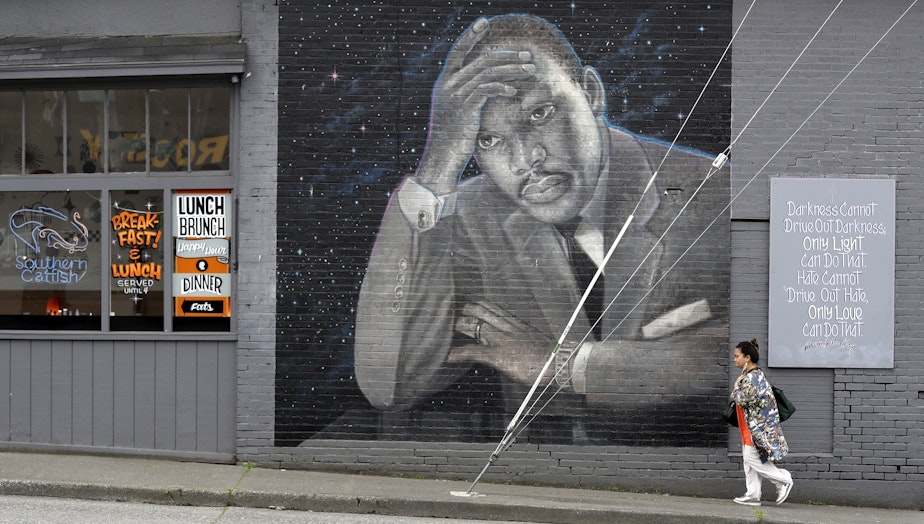Martin Luther King workshopped his 'I have a dream' speech in Seattle

Martin Luther King Jr. visited Seattle once, in 1961. Lines from the speech he gave at Garfield High would later be woven into his "I Have a Dream" address.
King was 32 years old when he came to Seattle. He was small-framed – several who met him would note this – charismatic, and considered radical.
He was known for leading boycotts down South, but this Northwest visit was before the March on Washington, the “I Have a Dream” speech and the Nobel Peace Prize. Still, he drew thousands.
There are no known transcriptions of the speeches he gave in Seattle, but his address to Garfield High School students, titled “The American dream,” has several lines that would make their way into the famous “I have a dream” speech two years later, in 1963.
On Nov. 8, 1961, a Wednesday, Martin Luther King Jr. checked into the Olympic Hotel in downtown Seattle.
The next day, King addressed 2,000 students in Meany Hall at the University of Washington. The hall was so packed that campus police had to close it “because of extreme overflow,” according to a typed student account in the university archives.
Sponsored

According to the University of Washington Daily student newspaper, King said that African-Americans in America must “take a stand for integration and stand up against segregation.”
King said 5 million black people were eligible to vote in the South but could not “due to the difficulty of literacy tests, often impossible to pass.”
He continued: “A Ph. D in law could never answer questions like, ‘How many bubbles are there in a bar of soap?’”
King said churches lagged behind. “They are an echo rather than a voice,” he said, according to the Daily. “A taillight instead of a headlight.”
Sponsored
Specifically: “The white church must take a stand,” he said. “The Negro church is already standing.”
This last line may have been a reference to the First Presbyterian Church in downtown Seattle, which had made a gentleman’s agreement to let King use their space. When white congregants protested, the church canceled.
Samuel B. McKinney, a Seattle pastor who had known King since their youth, recalled King’s response when he told him about the church wouldn't let him speak there: “You’ll look back and thank them,” King said. “Some people can kick you upstairs when they’re trying to put you downstairs.’”
Ultimately, the Temple de Hirsch Sinai synagogue invited King to use their sanctuary that Thursday evening.
The next day, Friday, King spoke at two assemblies at Garfield High School, at the heart of Seattle historically black neighborhood.
Sponsored
King told students they should do “creative” protest to break down barriers of discrimination. This was his “American Dream” speech, which his friend Rev. McKinney, in a taped recording, said was an earlier version of “I Have a Dream.”
“In those majestic words of the Declaration of Independence, words lifted to cosmic proportions: "We hold these truths to be self-evident, that all men are created equal, that they are endowed by God, Creator, with certain inalienable Rights, that among these are Life, Liberty, and the pursuit of Happiness." “This is a dream. It’s a great dream.
“The first saying we notice in this dream is an amazing universalism. It doesn’t say all white men. It says all men, which includes black men. It does not say all gentiles, it says all men, which includes Jews. It doesn’t say all protestants, it says all men, which includes Catholics. It doesn’t even say all theists and believers, it says all men, which includes humanists and agnostics.”
From “I Have a Dream”…
“I say to you today, my friends, so even though we face the difficulties of today and tomorrow, I still have a dream. It is a dream deeply rooted in the American dream.
“I have a dream that one day this nation will rise up and live out the true meaning of its creed: 'We hold these truths to be self-evident, that all men are created equal.'"

King flew out of Seattle on Saturday, Nov. 11.
The Seattle Times’ religion editor at the time summed up his visit like so:
“If he came as a preacher, his sermon was the gospel of human rights, as guaranteed to all in the Constitution. He called America a dream that has not been fully realized because it has divided itself because of racial segregation and religious bigotry.
“Dr. King, superbly educated and articulate, unquestionably is the leader of Negroes who take a militant position on civil rights. He has critics among Negro leaders who believe the Negroes should go slow – catch up with court decisions – consolidate and let time heal scars.
“Dr. King takes strong issue with this philosophy. ‘There is a strange illusion that time will solve problems,’ Dr. King says. ‘Time waits for no man. The time is always ripe to do right.’”
King would travel to seven more cities that month. Two of his appearances would be delayed by bomb threats. In Philadelphia, he would see doctors about a stab wound from 1958.
King’s friend, Rev. McKinney, would remain the pastor of Mount Zion Baptist Church until his retirement in 1998.
And 37 years later, the new pastor at First Presbyterian would be in touch …
“I saw a note from First Presbyterian church – typed, generated by a machine,” McKinney said in a videotaped interview. “It was an apology for what had happened. “I got him on the phone. He came to the church. I said I never expected this to happen…
“But he felt a rift in the church of the body of Christ and he felt he could do something to heal that rift, he would do it.”


